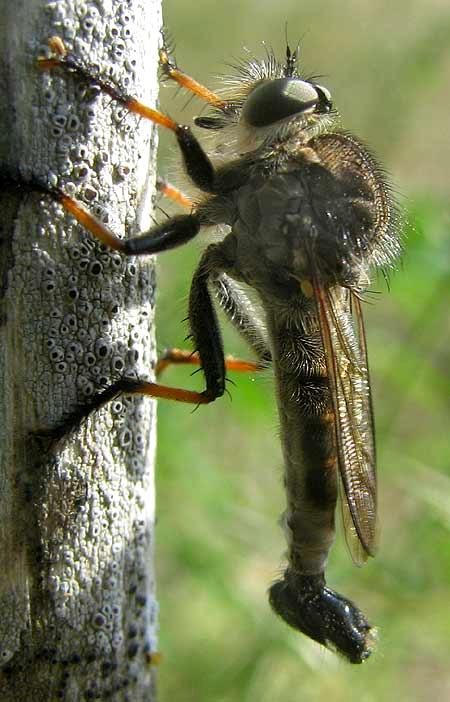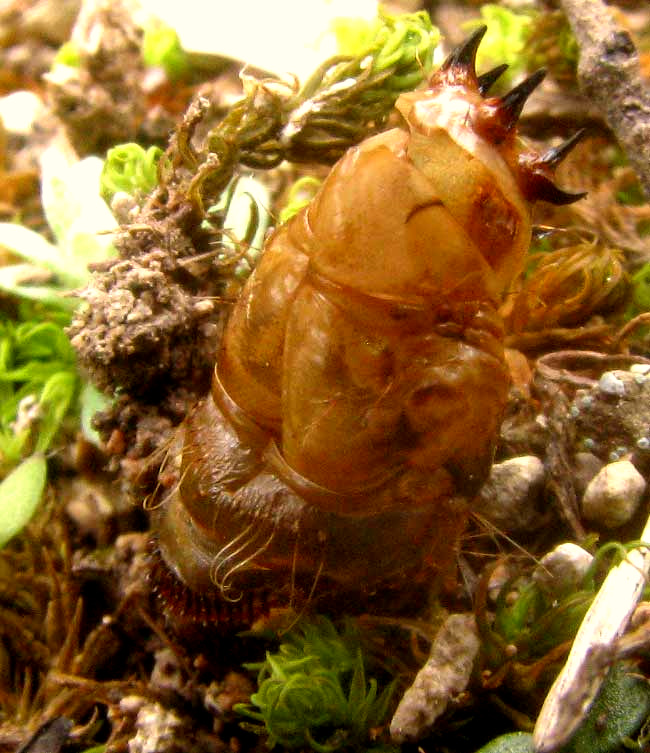Excerpts from Jim Conrad's
Naturalist Newsletter
from the May 26, 2013 Newsletter issued from the Frio Canyon Nature Education Center in northern Uvalde County, southwestern Texas, on the southern border of the Edwards Plateau; elevation ~1750m (~5750 ft); N29.62°, W99.86°; USA
ROBBER FLY
While I photographed a wildflower an unusual fly-like critter a little less than an inch long (±2cm) landed on a stem next to me, as seen below.

This is a robber fly, EFFERIA AESTUANS, a male one. He's clearly a male because the black item stuck at the abdomen's tip is the genitalia. Females lack such an appendage, their abdomens ending with slender points.
Efferia is a big genus -- 22 species are listed just for Arizona -- and they're hard to distinguish. However, they're all known as robber flies. Robber flies eat many kinds of flying insects, from mosquitoes and June bugs to honeybees, whom they catch in flight. Upon capturing prey the flies land, inject their victims with digestive enzymes that liquefy the prey's innards, and finally suck out the victim's juices.
You might remember the robber fly we saw in the Yucatan, a male who landed on a leaf behind my hut, warming his body and oversized genetalia in the rising sun. You can compare our present one with the Yucatan one at http://www.backyardnature.net/yucatan/robber-f.htm.
Robber flies are members of the fly family Asilidae, of which about 7,000 species have been identified worldwide.
from the December 22, 2013 Newsletter issued from the Frio Canyon Nature Education Center in the valley of the Dry Frio River in northern Uvalde County, southwestern Texas, on the southern border of the Edwards Plateau; elevation ~1750m (~5750 ft); N29.62°, W99.86°; USA
MYSTERY EXUVIA
Down on hands and knees looking for mosses producing sporangia to identify (none found) I came upon one of the weirdest things I've seen in a long time, which you can see below:

Sticking from the soil, it was about 3/8ths inch high (1cm). It sort of looked like a cicada skin, but they display mouthparts and legs, while this bore neither. On the head, spines are pointed forward, and just below the spines the skin is ripped open. The object apparently got there by its own movement, despite there being no legs. Reviewing the metamorphosis formula to see when such a thing might result -- egg --> larva --> pupa --> adult -- none of this made sense.
I sent the picture to Bea in Ontario, telling her I suspected it was a pupa exuvia, the word exuvia referring to remains of an exoskeleton and related structures left after insects, crustaceans, arachnids and the like have molted. Bea Googled the keywords "pupa exuvia" and to our astonishment, at BugGuide.Net, an identified picture perfectly matching ours turned up.
In BugGuide's terms, what we have is an "Asilid Pupal Case," which translates into "the discarded exoskeleton of the pupa of a robber fly." Robber flies belong to the Robber Fly Family, the Asilidae. You can see an adult robber fly found here last May at the top of this page.
So, how did the exuvia of a robber fly pupa end up poking from the ground? The mystery is solved upon learning that pupae in the Robber Fly Family are "exarate," which means that the pupa's legs and other appendages are free and extended. Despite our seeing no indications of legs in our photo or the photos of others on the Internet, anatomists tell us that they're there, so we must be overlooking them. Knowing this we can imagine this discovery's story:
After spending one to three years underground, at first probably eating decaying plant material but after growing larger and molting tending to eat invertebrate animals in the soil. The last larva stage forms a pupa presumably oriented with the front end with its spikes pointed upward near the soil's surface, maybe the spikes dissuading creatures like mice from poking their noses onto it. When the grub is ready to metamorphose into an adult robber fly, with its hard-to-see legs it tunnels to the soil's surface, and a little beyond, so that the adult can emerge from a split at the top of the pupa's exuvia and escape into free air.
Wikipedia has an unusually detailed account of the life history of robber flies at https://en.wikipedia.org/wiki/Asilidae.